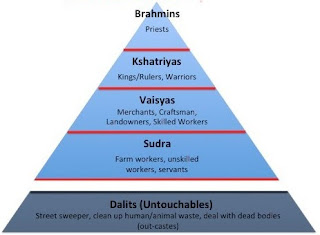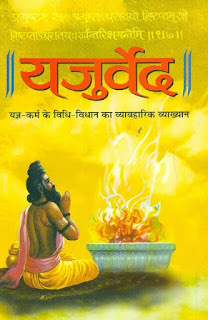In the previous post, we saw the various developments during the Vedic age. This post, although a small deviation from following the timeline, is to look at what the Vedas have to say and also about the caste system.
All the ancient Hindu texts are classified as Shruti and Smriti at a high level. Shruti translates to “what is heard”, these texts are the ones that have been passed generation over generation by the great sages of Hinduism and are author-less i.e. a single person is not associated with their creation. These holy texts lay down all the principles or Dharma that are to be followed in Hinduism. The Vedas fall under Shruti along with the Upanishads, which are considered the branches of Vedas. Upanishads are also known as Vedanta, which translates to the end of Veda, meaning they are the conclusion (anta) and the goal of the Veda. There are 108 Upanishads which are divided among the four Vedas. For further details on Upanishads, I would suggest you to take a look at the Vedic Heritage site.
Smriti translates to 'recollection' or 'what is remembered', these texts are various interpretations of the Shrutis, that were created/used to spread the idea of the Vedas among the masses. Smriti texts are usually attributed to an author and are written down traditionally. The vedic people believed that in order to spread the knowledge of the dharmas, it had to be done either using hymns/poems (Gitas) or using structured stories (Puranas). Apart from Gitas and Puranas, Smriti texts also include Vedangas (auxiliary sciences in Vedas), the epics of Ramayana and Mahabharata, Bashyas (reviews and commentaries of the Shruti texts), and Nibandhas (digests covering politics, ethics, culture, society, and arts).

|
| Ramayana and Mahabharata |
Vedas
Rig Veda
Rigveda is the oldest of the Vedas, and is also the largest of the four. It is not a single book but a composition of various books that were compiled at various points in time. Rig means ‘praise’, the hymns in the Rigveda praise various deities of Hinduism - Indra, Agni, Vayu, Varuna, Soma, Usha, Surya, Prithvi and others. Apart from the praises, the Rigveda also talks about the various religious customs that have to be followed. The most intriguing discussions in Rigveda are about cosmology, mystic forces, the existence of the Universe and other metaphysical issues. 10 Upanishads are associated with the Rigveda.
Yajur Veda
Yajurveda is a compilation of rituals offering mantras that are to be chanted by priests when they perform a religious ceremony such as marriage. These mantras are usually recited by the priests in front of the holy fire or Yagnya. Yajurveda is broadly classified into two parts - the Krishna (Black) Yajurveda and Shukla (White) Yajurveda. The Krishna Yajurveda is an unarranged, unclear, and disparate collection whereas the Shukla Yajurveda is a well structured collection. 51 Upanishads are associated with the Yajurveda, 19 belonging to Shukla and 32 to Krishna.
Sama Veda
Sama is translated as ‘song’, Samaveda is considered the Veda of melodies and chants. Samaveda reiterates the principles established in Rigveda via hymns, it consists of chants and hymns towards various Rigvedic deities. 16 Upanishads are associated with the Samaveda.
Atharva Veda
Atharvan denotes directions and mantras to ward off evil and hardship and also contains philosophical thoughts. It is considered to be the knowledge for everyday procedures. Atharvaveda consists of hymns, chants, and prayers that are believed to possess the power to cure illnesses and prolong lives. This Veda also has references on how various herbs can be used to treat certain illnesses and injuries. Atharvaveda is considered as the root to Ayurveda, which is the Indian medicinal science. 31 Upanishads are associated with the Atharvaveda.
Varnas - the Class system
Varna or class is a concept that is found in scripts such as Manusmriti and Bhagavad Gita, which talks about the social stratification of people in four groups or classes viz. Brahmanas, Kshatriyas, Vaishyas, and Shudras. Each of these Varnas have specific duties to perform i.e. follow certain dharma. The Brahmans or Brahmins are the priestly class who have to follow the dharma of performing religious rituals, Kshatriyas are warriors who have to follow the dharma of protecting their tribe, the Vaishyas are merchants who follow the dharma of farming, producing and trading to earn wealth for themselves and their tribe, Shudras are workers who have to follow the dharma of serving the other classes as labourers, artists, or musicians.
It is important to note here that no-where in the Shruti or Smriti scripts it is mentioned that a person belongs to a certain class by birth. During the Vedic periods, every child regardless of class was allowed to attend the Gurukul (school) and attain knowledge (It is unclear if girls were allowed to attend these Gurukuls or if there was a different, girls-only establishment). After spending a few years at these institutions the individual could follow a profession based on the knowledge gained and would accordingly belong to the respective class.
When did the transition to classify people based on birth rather than knowledge begin?
It is widely believed that this transition happened as people wanted the knowledge to stay within their families and refused to share it with anyone else. Each of these families that contained specific sets of skills and knowledge were identified as a jati (caste), hence giving birth to the caste system in India. It is after this separation and concentration of knowledge, restriction on inter-marriage and even inter-dining came into existence. It is explained in detail in this paper by M V Nadkarni how Hinduism is not to be blamed for the birth based caste system and also how various Hindu saints fought against this division.
What about the Dalits?
Dalits or antyajas are a fifth class of people, who were considered out-castes and had to perform the tasks such as sweeping, cleaning, and dealing with the dead bodies. This class has no mention in Vedas as it was a one that was established later in time. Some scholars believe that the Dalits were part of the Shudras but due to growing classification among them, a separate class was formed. Others believe that this class was established merely to exploit people who did not follow the rules set by the so-called upper castes.

|
|
The hierarchy |
What's next in the series?
Now that we have seen about the Vedas and the Varnas, it is time to move forward in the next post to look at the lives of Mahavira and Buddha.
Foot notes
The information provided here is based on my research of various sources. If you feel like this information is inaccurate, let me know and I would love to correct myself and learn more. In my encounter with various books I have seen that the history of India is mainly concentrated around the Indus valley and Delhi and very little information is provided of the southern and north-eastern parts, in this series I plan to cover all parts of India equally to the best of my efforts.
If you like the content, share this post!
Also let me know what topics you would want me to cover in the comments below. :)
- Aniruth


Comments
Post a Comment